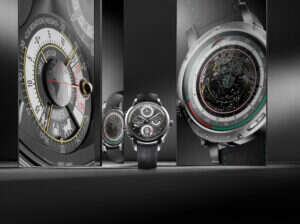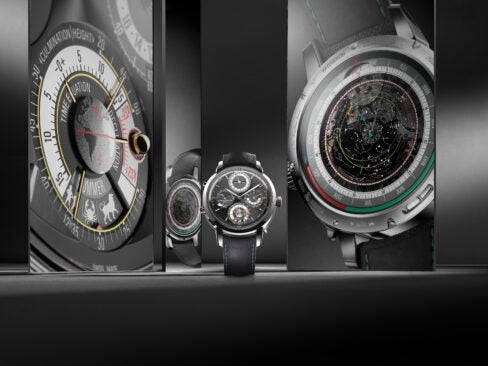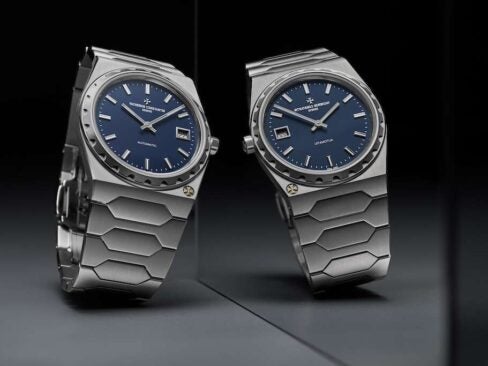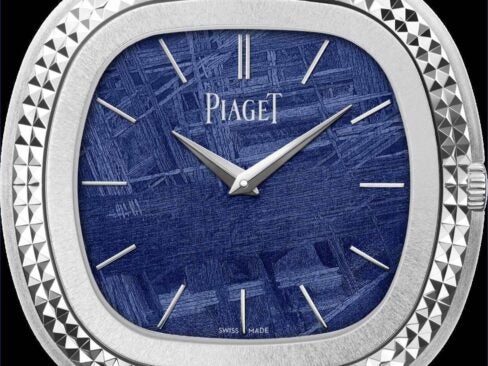By Zahra Al-Kateb
 The 14th Edition of the Grand Prix D’Horlogerie de Geneve is under way, and this year no less than 72 pre selected watches will be running to win the “Aiguille d’Or” Grand Prix.
The 14th Edition of the Grand Prix D’Horlogerie de Geneve is under way, and this year no less than 72 pre selected watches will be running to win the “Aiguille d’Or” Grand Prix.
With this year’s GPHG attracting record participation, all major watch groups are being represented, along with a number of independent companies.
Vote for your favorite amongst the following pre-selected watches and automatically participate in the drawing to win a Girard – Perregaux Vintage 1945 XXL Petite Seconde, worth $11372.29.
Here are the six finalists in the Chronograph category. Tomorrow we will be revealing the Tourbillon category.
 CHOPARD, L.U.C 1963 CHRONOGRAPH
CHOPARD, L.U.C 1963 CHRONOGRAPH
Beneath its classically elegant appearance, the L.U.C 1963 Chronograph is a highly technical and sophisticated watch. Its hand-wound chronograph calibre is distinguished by a sophisticated technical construction and a particularly high degree of finishing that earns it the Poinçon de Genève hallmark. Its firm roots in the tradition of fine chronographs stems from a comprehensive aesthetic, technical and historical approach, as well as Karl-Friedrich’s personal passion for the purest expressions of traditional watchmaking.
Hand-wound chronographs embody a spirit of nobility, along with technical and aesthetic perfection. They are the grand classic when it comes to short-time measurements and since they are not fitted with an oscillating weight that conceals much of the movement, they are ideally suited to showcasing impeccable craftsmanship. The L.U.C 1963 Chronograph thus has all the attributes of a true horological aristocrat.
 DE BETHUNE, DB29 MAXICHRONO TOURBILLON
DE BETHUNE, DB29 MAXICHRONO TOURBILLON
The DB29 Maxichrono Tourbillon, the result of seven years of research and development, is the only one of its kind.This exceptional patented chronograph, packed with innovations, embodies the essence of De Bethune’s watchmaking.
The rose-gold case of the DB29 with its smooth curves features the brand’s trademark cone-shaped lugs with closer strap attachments ensuring optimal comfort on the wrist.The double case back of this time-measuring instrument is fitted with an invisible hinge so as not to detract from its clean lines. A single push button, coaxial with the crown at 3 o’clock, operates the chronograph.
The design of the DB29 Maxichrono Tourbillon’s dial with its five central hands aims to make it easier and more attractive to read the chronograph indications by doing away with the small subdials of the conventional chronograph. The hands that give this watch its identity are designed to follow the different shapes and curves of the silver-toned dial.
This instrument measures long elapsed times with counters for 60 seconds, 60 minutes and 24 hours. The central chronograph hands are mounted on co-axial stacked wheels, a complex system that requires real technical expertise to achieve. The maximum duration of the time thus measured is a generous 23 hours, 59 minutes and 59.9 seconds.
Chronometric precision: 36,000 vph silicon/titanium tourbillon, 10th of a second measurement
Thanks to the high frequency ensured by the De Bethune 30-second Tourbillon in silicon and titanium oscillating at a rate of 36,000 vibrations per hour – featuring a speed ideally suited to wristwatches and the lightest on the market with its 63 parts weighing a total of 0.18 grams – time is accurately measured.
 MONTBLANC, MONTBLANC TIMEWALKER 100
MONTBLANC, MONTBLANC TIMEWALKER 100
A patented chronograph function enables the Montblanc TimeWalker Chronograph 100 to perform a feat that’s seldom achieved by mechanical timepieces: it can measure elapsed intervals to the nearest 100th of a second. To accomplish this, the watch relies on the Montblanc Manufacture’s nearly century-old competence for measuring intervals to the nearest 100th of a second. The Minerva Manufacture, which would later become the Montblanc Manufacture in Villeret, sparked enthusiasm among specialists in this disciple when it launched its first mechanical 100th-of-a-second stopwatch in 1916. Subsequent versions were equipped with a chronograph hand that requires just one second to complete a full 360° circuit of the dial. Precisely this principle is employed by the Montblanc TimeWalker Chronograph 100 with its newly developed manufacture calibre MB M66.25. This high-performance manufacture calibre is embedded in a case crafted from materials which are used in racing cars and which further accentuate the movement’s innovative mechanisms. Highly advanced materials and mechanisms are uncompromisingly combined with a manufacture movement that is built in accord with the centuries-old tradition of the art of Swiss watchmaking. Meticulous manual craftsmanship and decorative finishes uphold the rigorous standards of even the most demanding connoisseurs.
In the Montblanc TimeWalker Chronograph 100, Montblanc’s watchmakers have successfully united performance-oriented innovation and the finest horological tradition.
For a watch to measure intervals with 100th-of-a-second precision, its balance must be able to vibrate at a frequency of 360,000 semi-oscillations per hour (50 hertz). In conventional chronograph wristwatches, one and the same balance drives both the ordinary time display and the chronograph mechanism for measuring elapsed intervals. Activating the “start” function creates a connection between the going train and the chronograph; this link is severed when the “stop” function is triggered.
Due to its need for a frequency of 360,000 semi-oscillations per hour, the Montblanc TimeWalker Chronograph 100 cannot rely on the same mechanical principle as a conventional chronograph calibre, which vibrates at a much slower pace of 2.5 or 4 hertz. This necessity prompted the watchmakers in Villeret to devise a solution with two balances. A large, massy, screw balance oscillates at a frequency of 18,000 A/h (2.5 Hz) to ensure the precise rate of the going train, while a small balance paced at the extremely high frequency of 360,000 A/h (50 Hz) regulates the chronograph function. Rather than remaining continually in motion, the separate balance for the chronograph begins to vibrate only when the “start” function is activated by a flexible steel lamella (called fouet) mounted behind the arrowhead of the chronograph rocker. When the “stop” function is triggered, this slender steel plate arrests the tiny 50-Hz balance and holds it motionlessly in place until the next elapsed-time measurement begins.
Emblematic of OMEGA’s bold style, forward-thinking innovation and adventurous spirit, the all-black OMEGA Speedmaster “Dark Side of the Moon” is a sleek and sporty new addition to the brand’s iconic chronograph collection.
The 44.25mm case in brushed and polished ceramic, fashioned from a single block of black ceramic, is complemented by a matching black ceramic dial crafted from black zirconium oxide. It features striking 18K white gold applied indexes as well as two blackened sub-dials.
These two sub-dials are made possible by the innovative placement of the 12-hour and 60-minute counters on the same sub-dial at the 3 o’clock position, allowing a comfortable and intuitive chronograph reading.
The matt chromium nitride tachymeter scale – among the most identifiable design features of the Speedmaster – stands out on the polished ceramic bezel. The two polished ceramic chronograph control pushers on the case function totally independently.
The “Dark Side of the Moon” is sure to find a strong following among Speedmaster fans and watch enthusiasts who want to combine the impressive legacy of a remarkable chronograph with the best series-produced mechanical watch movement in the world.
The TUDOR Fastrider Black Shield, a distillation of strength and virility matched with supreme reliability. In this spirit, and to accompany the launch of the TUDOR Fastrider Black Shield, TUDOR – in collaboration with its partner, Ducati – has customized the one-of-a-kind Diavel Carbon model with a black matt finish on the whole motorcycle and bronze highlighting on the details.
Monolithic and scratch-proof, the TUDOR Fastrider Black Shield’s monobloc case in matt black ceramic is an archetype in its genre. Not only is it fashioned using nothing but high-tech injected ceramic – not ceramic applied to another material as a coating – but it is also made entirely in one process. The whole case is produced as a single piece – a unique operation for watches in this segment. In addition to the noble aesthetics of this chronograph, the extremely complex procedure adopted for its manufacture – a result of technological expertise acquired in perfecting the bezel for the Pelagos line – ensures that both the middle case and bezel are exceptionally reliable and resistant.
Waterproof to a depth of 150 metres (500 feet) and fitted with direct-action pushers and a screwdown crown in PVD-treated steel, the 42 mm case houses a self-winding chronograph movement with a power reserve of approximately 46 hours. The matt finish selected for this monobloc case shows off to particular advantage the clean curves and taut lines of this chronograph. It also accentuates the watch’s dimensions and the tachymetric scale engraved on the bezel. The strength emanating from the case is highlighted by the bronze-tinted features that punctuate the dial. A unique statement of precision and performance, this chronograph is available with either a rubber strap or a beige Alcantara® strap with black stitching.
A movement well-known to collectors beats at the heart of the latest Zenith watch: Calibre 410. Created in 1969 as a variation of the legendary El Primero, it combines the performances of the world’s most accurate automatic chronograph with triple calendar and moonphase indications. Steadily perpetuated over the years, it now appears in a form bridging past and present, orchestrated around a display loyal to the historical model, while the case displays resolutely contemporary lines.
While one man took a small step that proved a giant leap for mankind by walking on the moon, Zenith did much the same for watchmaking that same year. After seven years of research, the Manufacture presented El Primero, the first ever integrated automatic chronograph, also equipped with a date and a tachometric scale. It was already an impressive feat in itself, backed by exceptional precision since the calibre beat at the exceptional speed of 36,000 vibrations an hour, corresponding to 1/10th of a second precision. That same year, buoyed by the daring that has guided its steps since its founding in 1865, as confirmed by the over 300 patents registered to date, the Manufacture Zenith further rolled back the boundaries of its art by equipping its calibre – that had become an instant watch industry icon – with triple calendar and moonphase indications. The name of this movement also born in 1969 was the El Primero 3019 PHF, later referenced as 410. Built around a column wheel and endowed with a 50-hour power reserve, like all the El Primero movements that would punctuate the Zenith collections, Calibre 410 made its way through the decades until the year 2000 thanks to remarkable reliability coupled with extraordinary precision.
Almost half a century after its creation, El Primero Calibre 410 has evolved in various ways, including having a complete model named after it and finding its way back into the legendary El Primero collection. Introduced this year with a silver-toned dial, it reproduces the original function layout in a distinctively 1970s spirit. The days and months are counted off at 10 and 2 o’clock respectively, while the date remains imperturbably enthroned between 4 and 5 o’clock. Merging into the hour subdial at 6 o’clock, the moonphase depicts the revolutions of the night star through a special-shaped aperture with two rounded cut-outs reproducing the dark part of the moon. The latter thus reveals its successive phases – and faces – throughout its cycle (waxing moon, full moon, waning moon, new moon). The disc bearing two moons is driven by a 59-toothed wheel corresponding to two lunar cycles (2 x 29.5 days). This is a model that reinvents the subtlety of the moonphase function by combining technique with poetry.













